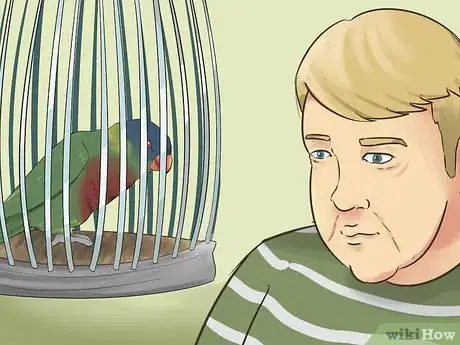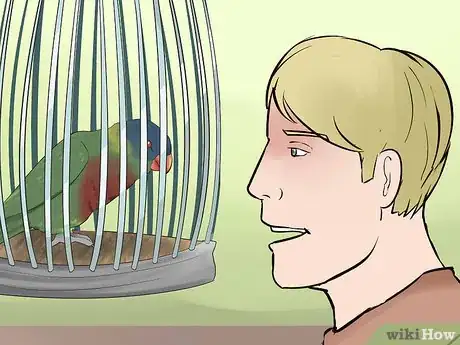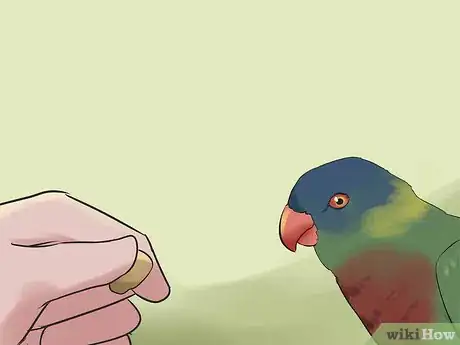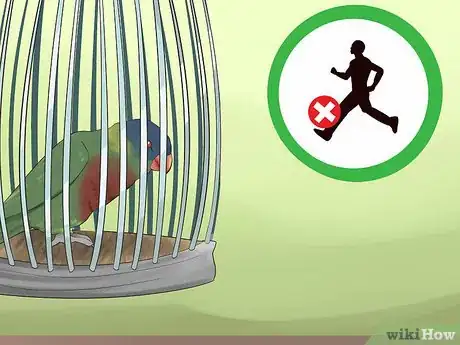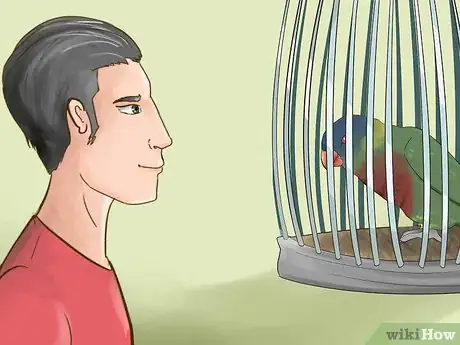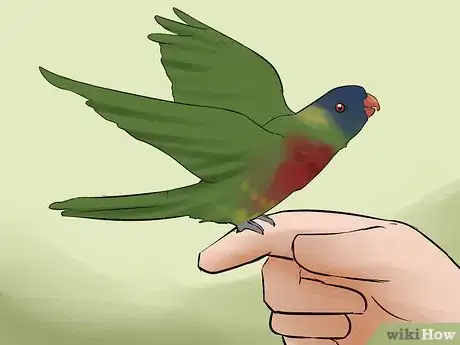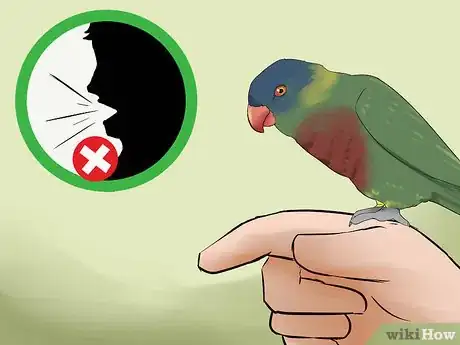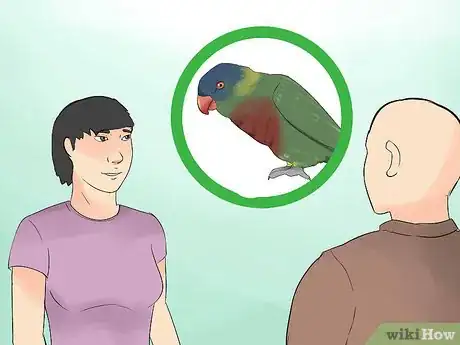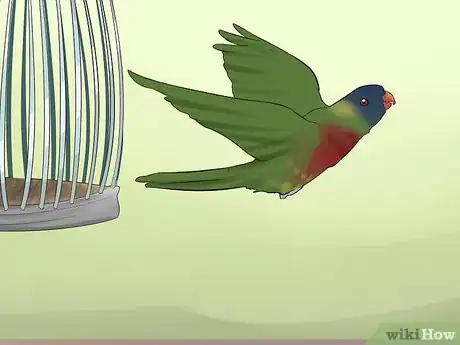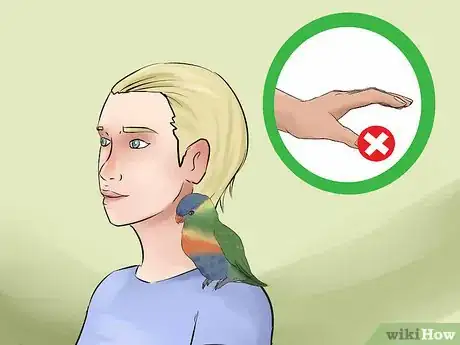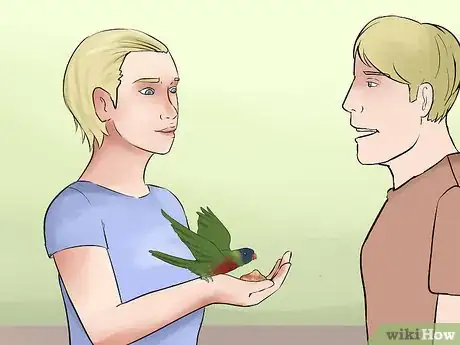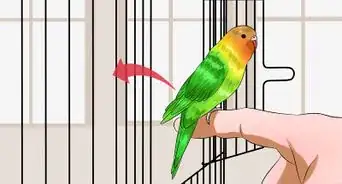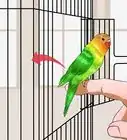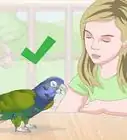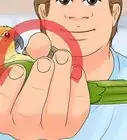This article was co-authored by Pippa Elliott, MRCVS. Dr. Elliott, BVMS, MRCVS is a veterinarian with over 30 years of experience in veterinary surgery and companion animal practice. She graduated from the University of Glasgow in 1987 with a degree in veterinary medicine and surgery. She has worked at the same animal clinic in her hometown for over 20 years.
This article has been viewed 13,589 times.
Lories and lorikeets are social birds that can easily become a part of your family. However, these birds are not immediately social animals like a dog or a cat would be. Lories and lorikeets are close to their wild roots, so they need to learn that their humans are trustworthy. Start by spending time with your pet bird and letting them get used to you. When you introduce your bird to people, make sure they understand how to interact with a lory or lorikeet.
Steps
Interacting With a New Bird
-
1Place the bird’s cage near you. The more time spent with your lory or lorikeet, the better socialized they will become. You have to get your bird used to you and other people. Put the cage somewhere where your bird can see you and others so they can get used to you.[1]
- Sit close to the cage or walk by it throughout the day. Let them realize you are not a threat by becoming part of their environment.
-
2Talk to your bird. Interact with your bird by talking to them. Whenever you enter the room or walk by their cage, speak to them. Talk to them in different tones of voice to rouse their curiosity. You can even try singing to them to get them used to you.[2]
- Do this multiple times each day.
Advertisement -
3Offer the bird food. You can try to build the trust between you and your lory or lorikeet by sharing food. Birds often feed each other, so offering the bird food can help establish that trust and relationship. Try feeding them different foods so they can stay curious and learn to trust you.[3]
- If the bird pecks at your hand, or if they always stay out of reach of your hand, offer food in a wooden spoon. This is less threatening for the bird, and still provides them with food intensives.
-
4Avoid sudden movements at first. When you first get your lory or lorikeet, avoid any sudden movements or loud sounds. They are prey birds, so they may see that as a threat. Whenever you are around them, move slowly in a controlled manner. Eventually, the bird will get used to you.[4]
- For example, don't reach towards the bird quickly or run over to the cage. Instead, move in a calm manner past the cage, or reach into the cage in a controlled way.
-
5Be patient. Not all birds will become socialized and accept you at the same rate. Some birds have traumatic events in their past that have made them distrustful to humans. Others may have a difficult personality. Remember to keep interacting with your bird and to stay patient. Eventually, your bird will trust you wholeheartedly.[5]
Spending Time with Your Lory or Lorikeet
-
1Play with your bird regularly. Spending time with your lory or lorikeet and playing with them daily helps to socialize them. Use toys and different games to amuse them. You also may bring them with you into different rooms throughout the day.
- For example, you may pull toys out of their cage and play with them with your bird. You can also put an empty box on the floor with something inside they can chew, and then gently tap the box with something until you finally place it in their view. You can also try playing peek-a-boo with a toy.
- Lories and lorikeets love just about every kind of toys. They love foot toys, balls, cardboard boxes or rolls, and toys that make noise. You can use just about anything to play with your bird.
- Take the lory or lorikeet into the bathroom with you when you’re grooming yourself, or bring them in the living room. Just don’t take them into the kitchen because kitchen fumes can be harmful to birds.
-
2Play instructional games with your bird. Playing games is important to keep your lory or lorikeet happy and healthy, but it can also help socialize them. Instructional games are particularly important because it helps tame your bird, build trust, and let them know that you are the one who can guide them.
- For example, you can teach your parrot to get your attention through spreading their wings instead of screaming at you. Whenever they spread their wings, spread your arms and say “Eagle pose!” Practicing this over and over will show your parrot this positive behavior.
- You can also try to teach the bird how to slap your hand with their foot using a verbal cue.
- Give the lory or lorikeet a lot of praise and treats when they perform a new behavior learned in your instructional games.
-
3React positively to behavior problems. You may unknowingly reinforce negative behavior by the way you react to behavior problems like screaming and aggression. If you scream at a screaming bird, you are giving it positive reinforcement, just as you are positively reinforcing biting behavior by getting angry. Try to react calmly and positively to get the behavior you want.
- Most negative behaviors happen when your bird is upset. Walk away from your bird and calm down before interacting. This also gives your bird time to calm down. Approach them later more calmly.
Socializing Your Bird with Others
-
1Tell visitors to ignore the bird at first. As you begin socializing your bird, instruct your visitors to ignore the bird. Many people may want to run up to your lory or lorikeet’s cage to see the bird, but this could reinforce negative associations for your bird. Keep visitors away from the bird for around 10 to 60 minutes.
- This helps your bird watch the people and determine they are not a threat.
- Tell your visitors, “I can introduce you to my lorikeet soon, but for now we need to ignore them while they get used to new people.”
-
2Explain to guests how to approach your lory or lorikeet. Your bird has a very specific way it needs to be approached. Especially if you are teaching it how to be social, you need to make sure everyone handles your bird in the correct way. This helps provide positive associations for your bird with strangers.
- Go through the steps on how to handle the bird, including how to pet it. If your bird will allow it, demonstrate with the bird.
- Explain to your guests that the bird is not a dog, cat, or child, and they cannot treat it like most pets.
-
3Allow the bird out of the cage. After your guests have been in your home for a period of time, you can let your lory or lorikeet out of their cage. Make sure that the guests do not approach the bird, but that the bird approaches when they feel comfortable. This helps the bird retain control and feel out the situation.
- Explain to your guests, “Don’t approach the bird, but allow the bird to come to you. It’ll take a few minutes to feel comfortable, but then it will get curious.”
-
4Make visitors act as a human perch. When your lory or lorikeet is getting used to people, have people only let the bird perch on them. Don’t let visitors put their arm out towards the bird because this could spook or upset the bird. Letting unfamiliar people make motions towards the bird can cause them to mistrust strangers.
- Tell your visitors that they should remain still and not interact with the bird if they decide to land on them. They shouldn’t pet or touch the bird while they’re perching on them.
-
5Allow the bird to build trust with the person before they move towards it. No one should ever move towards a lory or lorikeet before they build trust. This trust can be established by letting the bird use them as a human perch, or by being around the bird and letting them get used to the person.
-
6Use tricks to help your bird get used to stepping up to strangers. You should already have your lory or lorikeet trained before socializing them, so you can use this training to get them used to people. After the bird gets used to a person, you can give the person treats. Have the person cue a trick, and then to receive the treat, the bird has to step up onto the arm.
- After the bird gets used to this, then have the bird step up onto the visitor’s arm before they get the treat.
Acclimating Young Birds to Different Situations
-
1Socialize young birds with other birds. Lories and lorikeets need to learn socialization with other birds, especially if you are going to keep more than one bird. If you have a young bird, introduce them to other birds and let them interact. This helps them avoid being aggressive or angry with any other birds you get.[6]
-
2Introduce young birds to a variety of different people. If you have young lories and lorikeets, you should try to get them used to a variety of different people. This helps them get used to people and not be frightened by people who look different than you.
- For example, you can bring people around them that are different genders or ethnicities or with different color hair. You can also allow them to get used to people who wear hats, glasses, or other accessories.
-
3Let young birds experience changes in their environment. Another way to socialize young lories and lorikeets is to let them experience many different things. This helps them adapt to changes in their homes and piques their curiosity.[7]
- Change things around in your home or in the room the birds are kept. You can also take the birds into different rooms so they can experience different environments.
- Play music around your bird, let them walk on different surfaces, and let them be moved around in a basket.
-
4Feed young birds various foods. Another thing that can help your lory or lorikeet become socialized is to feed them an array of foods so they get used to any food that they are given. This also helps them learn that curiosity is a good, safe thing. Fostering their curiosity helps your bird be more involved with their surroundings.[8]
References
- ↑ https://brucebyfield.com/2012/05/23/the-five-assets-for-socializing-parrots/
- ↑ https://brucebyfield.com/2012/05/23/the-five-assets-for-socializing-parrots/
- ↑ https://brucebyfield.com/2012/05/23/the-five-assets-for-socializing-parrots/
- ↑ https://brucebyfield.com/2012/05/23/the-five-assets-for-socializing-parrots/
- ↑ https://brucebyfield.com/2012/05/23/the-five-assets-for-socializing-parrots/
- ↑ https://www.beautyofbirds.com/earlysocializationofpetbirds.html
- ↑ https://www.beautyofbirds.com/earlysocializationofpetbirds.html
- ↑ https://www.beautyofbirds.com/earlysocializationofpetbirds.html
About This Article
To socialize a lory or lorikeet, start by placing its cage in a spot where it can see you. Every time you pass by the cage, talk to your bird so it gets used to your voice. You can also use different voice tones to keep it interested and alert. Additionally, bond with your bird by feeding it a variety of treats by hand. Try to keep all of your interactions with your bird positive and calm to build trust and reinforce positive behaviors. If you bird is acting in ways that you don't approve of, simply walk away and ignore it for a few minutes. For more tips from our Veterinary co-author, including how to safely let your bird out of its cage, keep reading!
